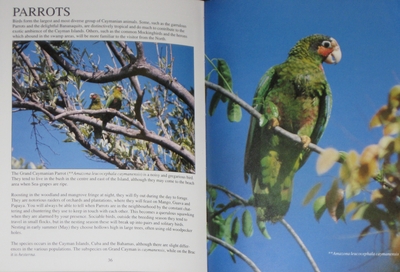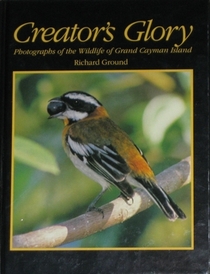Reviewed by Grant McCreary on March 24th, 2009.
Unlike some other Caribbean islands, the Caymans are not known for their wildlife-watching opportunities. They don’t boast a large bird list or the single-island endemics that draw birders elsewhere. Little Cayman, however, is essentially a sparsely populated wildlife refuge. And even on the much-more-populated and touristy Grand Cayman Island, there are opportunities to see some very cool animals and plants. Grand Cayman resident Richard Ground created this book to showcase and celebrate the wildlife of his home.
In the introduction, the author/photographer makes three disclaimers about his book:
- It is not a field guide
- It is not complete
- The photos are the work of an amateur
Indeed, this is decidedly not a field guide, but it could still help identify some things, especially those for which you don’t have a traditional guide (which would probably be everything but the birds).
This is more of a photographic sampler of the island’s flora and fauna. A diverse selection is shown, including orchids, butterflies, other insects, frogs, lizards, and other land animals. And, of course, birds. But the author has chosen to omit certain groups, including snakes and mammals (of which there are very few native species, mostly bats).
Over half of the book is dedicated to the island’s birds. Like the other groups, not all of them are included, but it does show the majority of the ones that visitors would be most interested in seeing. The only notable absentee is the West Indian Whistling-duck.
Most of the birds that did make the cut are illustrated in multiple photos, depicting a wide range of poses and behaviors. For example, there are no fewer than 10 shots of the ubiquitous Bananaquit, including a great sequence showing one “stealing” a flower’s nectar.

As the photographer warns, it is immediately obvious that these photos are not of professional quality. The non-avian subjects fared the best, and many of them are quite good. But birds are much more difficult to photograph well. Some turned out very well, though, and any photograph of a Mangrove Cuckoo is a good one. But overall, these photos are like what you would find on most bird blogs – identifiable, and better than what I could do, but not worthy of publication in a fine art book.
But that’s ok! That wasn’t the author’s goal. Rather, he wanted to help visitors and fellow residents appreciate the island’s natural heritage. And he succeeded.
The text also helps achieve this goal, not only identifying the picture’s subject, but also telling a little about it. The book’s short introduction to the Caymans may also be helpful for visitors.
Recommendation
I think Creator’s Glory is intended for residents and visitors of Grand Cayman that have some interest in nature, but aren’t exactly hardcore. And they are the ones that should get the most out of this book, as it will likely enhance their experience on the island.
It will not do as much for experienced birders, especially if they have the equipment and skill to take their own photographs. (Although the non-bird sections may come in handy). But this may still make a nice memento for non-photographers. Personally, I’m glad I picked this up as a souvenir. Whenever I see the Cuban Parrots in this book, I can’t help but remember my encounter with them (my first wild parrots!). And the iguanas and Viteline Warbler at the Botanical Gardens, and…
I purchased this book from a Grand Cayman bookstore in 2004. I assume they are still available there. Otherwise, it appears that the only way to get this book outside of the Caymans is to buy it used.
Disclosure: I get a small commission for purchases made through links in this post.






Comment